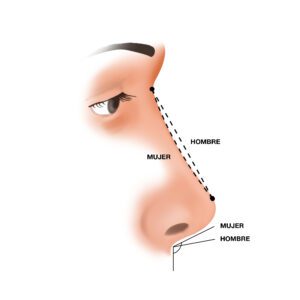A feminine nose is typically smaller, narrower, straighter, and more symmetrical than a masculine one. It usually lacks pronounced bumps and tends to have a slightly upturned tip with a greater nasolabial angle. That’s why feminizing rhinoplasty, or nasal feminization surgery, will help you to achieve a more feminine appearance to the face.
Why is nasal feminization important?

Differences between a male and female nose. All rights reserved.
It’s true that there are as many types of noses as there are people in the world. However, patterns of symmetry and beauty help define the differences between a masculine and a feminine nose.
Masculine noses are generally larger due to a more prominent bone structure. But size isn’t the only difference. The men’s nose tends to emerge from the forehead at a sharper angle. The women’s nose is finer, narrower, and its connection to the upper lip has a different shape. So, it’s not just about size. Several subtle elements contribute to whether a nose is perceived as feminine or masculine.
The artistic vision of the surgeon in nasal feminization
That’s why, when performing feminizing rhinoplasty, the plastic surgeon must not only master the delicate surgical technique and possess an artistic eye for facial harmony, but also have deep knowledge of sexual dimorphism to offer the best approach for each case.
The surgeon must analyze each angle and structure of the nose to achieve an optimal and natural result.
For example, while the male nasolabial angle is typically around 90 degrees, in women it ranges between 95 and 100 degrees. Women also tend to have narrower, more delicate nostrils and softer nasal contours. The forehead-to-nose transition is also more gentle and open in women.
Technological advances in feminization rhinoplasty
 Today’s technology allows surgeons to be highly precise in nose feminization surgery. For example, radiofrequency instruments enable bone cutting with a specialized saw that is less aggressive, resulting in fewer bruises and faster recovery.
Today’s technology allows surgeons to be highly precise in nose feminization surgery. For example, radiofrequency instruments enable bone cutting with a specialized saw that is less aggressive, resulting in fewer bruises and faster recovery.
On the other hand, piezoelectric technology allows surgeons to cut bone while preserving delicate tissues, leading to greater precision. At IM GENDER, we use these technologies not only for the nose but for all craniofacial remodeling procedures.
The procedure
Feminizing rhinoplasty is relatively quick. The surgery usually lasts about one hour and requires an overnight stay. It is often performed as part of a comprehensive facial feminization surgery rather than as a standalone procedure.
There are two main techniques: open and closed. For facial feminization, the open approach is preferred because it allows manipulation of all soft tissues and the creation of a new nasal skeleton with millimetric precision. Once the skin is placed back over the new structure, the result is a harmonious and feminine nose.

Beyond aesthetics: functional aspects
Feminizing rhinoplasty should not only address aesthetics but also functional breathing issues. Some trans women present with nasal obstructions due to deviated septum or enlarged turbinates – nasal structures that regulate airflow. Addressing these ensures not only a more feminine look but also healthy, unobstructed breathing.
Book your free medical appointment with the IM GENDER team and receive expert guidance.



